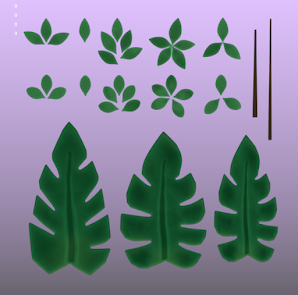Alright kids, the time has come for my last project in existence. After this, I'll retire and go raise crickets or something. I decided to do something very complex and realistic to boot, so future David will be very disappointed and salty with me. For now, though, that's future me's problem so who cares? I want to further delve into the power of trim sheets and understand what it takes to completely deconstruct an environment, and then make it in as short a time as possible with modular and duplicated assets. I'll be using as many tricks as possible this time to aid me since... this really is a big boy.

This is a piece by the wildly talented Will Burns, who is now working for Blue Mammoth. This cathedral was supposed to be a location in the now cancelled World of Darkness MMO. I contacted him and made sure to get permission for its usage, and since it's part of a cancelled game and it's been quite some time since the piece was posted, we got the green light to go ahead. This is a super demanding piece so I'm very much looking forward to seeing what I can do to impress Mr Burns!

My preproduction process has been refined since the last project. This time I started with some blockouts to understand how many unique pieces there are in the scene. Oftentimes you'll be able to get away with a ton of duplication and repetition, so recognizing these patterns helps you save time and effort, but also produce fewer assets with which to make your piece. Once this blockout was done, I sketched up a quick trim sheet layout and thought about what materials I would like to replicate a ton. Some materials are worth putting on a trim sheet and some aren't. For example, the sculpted parts of the altar could technically be a trim sheet, but it would be awkward and janky and it's just easier to do it uniquely and get it over with for time constrains.
I decided on these materials to represent in my trimsheet:
1. Brick pattern for walls
2. Big, flat bricks for arches
3. Dark border trimming to split wall regions
4. Sculpted relief borders to top pillars
5. Big rounded bricks for pillars
6. Pew Wood
Most of the materials on this trim sheet are for stone and the masonry on the walls, etc. By making an opening for the pew's wood, I can reduce the amount of effort I put into those pews. They're actually pretty excellent in terms of trim sheet usage since they're a solid slab of wood, straight planks slapped horizontally with simplicity as their driving theme. Sure, I might need to uniquely sculpt some of the weird siding and whatever footrest mechanism they might have (did they have those in medieval times, or were they just a solid block?), but that's completely worth it. Imagine having to uniquely sculpt what, 6 different surfaces and make it look like fine wood grain. Gross, and I love sculpting wood lmao.

My last bit of notes was this jumbled garbage. It's my attempt to understand how the unique pieces of this cathedral work in their spatial relationships with each other, and compositionally. For example, the balcony booth thingy on the left side of the reference (highlighted red on my blockout) can be broken down into a series of duplicated panels, hides, and a top and bottom part. Definitely better than modeling the whole thing and trying to make it work. Instead, I've made it modular and can do it in a shorter amount of time.
The altar is another beast altogether. It's massive, full of fine sculpted detail, and complex to boot in a structural sense. I decided to break it down into blocks and see how to make it modular, and I was successful to a degree. Obviously I'm going to have a ton of little pieces even if I can duplicate them, so my next idea to reduce the amount of work was to slap a trim sheet on this sucker.
Now, I know, I know. I just said this was a waste of time earlier. What I mean though, is the bordering and the flat parts of the altar. That whole center tower can be helped a lot by a marble and golden trim sheet, and then modeling some hides and unique pieces like the cross and the giant conical roof on top. There's no helping the statues nor the disgusting amount of relief sculpture in here, but hopefully by having a second trim sheet I can alleviate myself a lot of the pains of uniquely modeling this whole thing.
Lastly, there was a lot of research that went into this whole thing. This was actually the first thing I truly did because even though I loved art history and really enjoyed gothic architecture, that class doesn't prepare you for building one of these suckers. I gathered material on how pews look, confessionals, candelabra and chandeliers, and even the fanned vaulting that's so prominent in this piece. It's quite a marvelous pattern and I'm looking forward to cracking this puzzle open. It's a wondrous piece of architecture, really.
The idea is that by the end, I should be able to take a camera inside this building and get it relatively close to the altar, the confessional, the pews, etc and have it look good. With that in mind, this will be the first environment I make that will be both extremely complex but also able to be seen from multiple angles (since I used a lot of trickery to get my Bamboo Temple operational)
I hope you all are as excited to see the end of this project as I am!

































